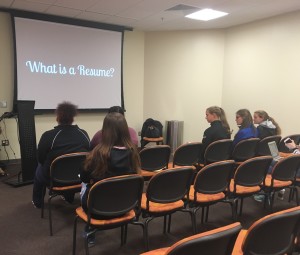Career & Professional Development Center Holds Special Event on the Essentials for a Good Résumé
This Tuesday, Oct. 11, the Career & Professional Development Center held a special event in the Lane Center on résumé basics. Amy Shimko, Director of Student Development, led the event with an informative presentation that allowed students to ask questions on the process of creating or editing their résumés.
Shimko began by explaining what a resume is and its purpose and importance. She then broke down the basics, informing students of the “do’s and don’t’s,” the format and its components, and the proper length of a résumé. Shimko’s advice was to have at least three people look over a résumé before sending it to a potential employer.

Also referred to during the event, was that employers typically have a pile of résumés to look through, which they then separate into piles of “Yes,” “Maybe,” and “Definitely Not.” To determine which pile a résumé should end up in, employers will look at each résumé for seven to 13 seconds. That’s not a lot of time to decide if a résumé is a “yes” or a “no,” so Shimko stressed that “a resume should have perfect formatting, grammar, and spelling. These components are what stand out to an employer for an automatic ‘yes’ or ‘no.’”
According to Shimko, a résumé should be broken down into about six basic subjects (give or take), all of which should fit on one page, maximum. Those topics include: Contact Info, a Skills Summary, Education, Experience, Volunteer and/or Activities, and References. All of these components should be arranged and balanced so that even when looked at quickly, the résumé is still visually appealing.
The objective category within a résumé used to be mandatory in previous years, but in more recent years, it is more so looked at as an option. Recently, what has been more appealing to the majority of employers is a skills summary. Instead of listing what the individual wants to take from the job, it’s now more appealing to the employer for an individual to list what he or she can do for the company.
In addition, Shimko went over the appearance of a résumé, and she stressed how it should keep a very “traditional and conservative” look to it. Unless one is going into a more creative profession, such as arts or graphic design, color print should be limited, and if used, should use more “dark, conservative colors” such as navy blue, hunter green, and a dark maroon.
Shimko also emphasized that color font should only be used for his or her name or the optional dividing line at the top of the résumé (this line divides the name from the bulk of the information). Résumés should also be printed on specific résumé paper, which is a thicker type of copy paper, but thinner than poster or card paper. This paper also should be in more conservative, traditional colors, such as white, cream, or light grey.
“It’s a very subjective process…part of my professional development revolves around making sure we have the most up-to-date information. NACE, the National Association of Colleges and Employers, is where we get a lot of professional development. It’s one of the leading professional associations for my area of career development….We try to give students the most progressive or the most up-to-date information to benefit them. We try to give the best guidance we can with what we know about the largest group of employers,” commented Shimko.
Of the ten students and one faculty member present at the event, all seemed to be very attentive and most even took notes during the presentation. Questions about where to place certain pieces of information in their resumes and what to put or not to put in their resumes were also brought up.
“The goal with having these types of events is to help students with the first steps alone their career paths…It really is a long process. It’s a big path to get to finding your dream job and this is just one of those tiny steps at the beginning that’s going to get [students] there,” comments Shimko.
The Career & Professional Development Center holds multiple events every semester to help guide students along their career path journey.
“I’ll do a session on finding a good internship. I do sessions on when [students] get that internship, how to be a good intern, and so we try and time them appropriately, so the internship sessions will be leading up to summer when students will be looking for a student summer internship,” said Shimko.
The Career & Professional Development Center is in 124 Sand Springs Hall or students can call 301-687-4403. There is also résumé paper for free at the Center at a maximum of 20 sheets per day.
The Center will be hosting the Career Expo on Friday, Oct. 21. During this event, each academic department is given the opportunity to have alumni come back and share their experiences. The Center will also have representatives at the Majors Fair on Wednesday, Oct. 26 from 11-2 p.m. This semester, the Career & Professional Development Center will also be at the Grad Fair, offering students the opportunity to have professional pictures taken for possible career advancement opportunities.




